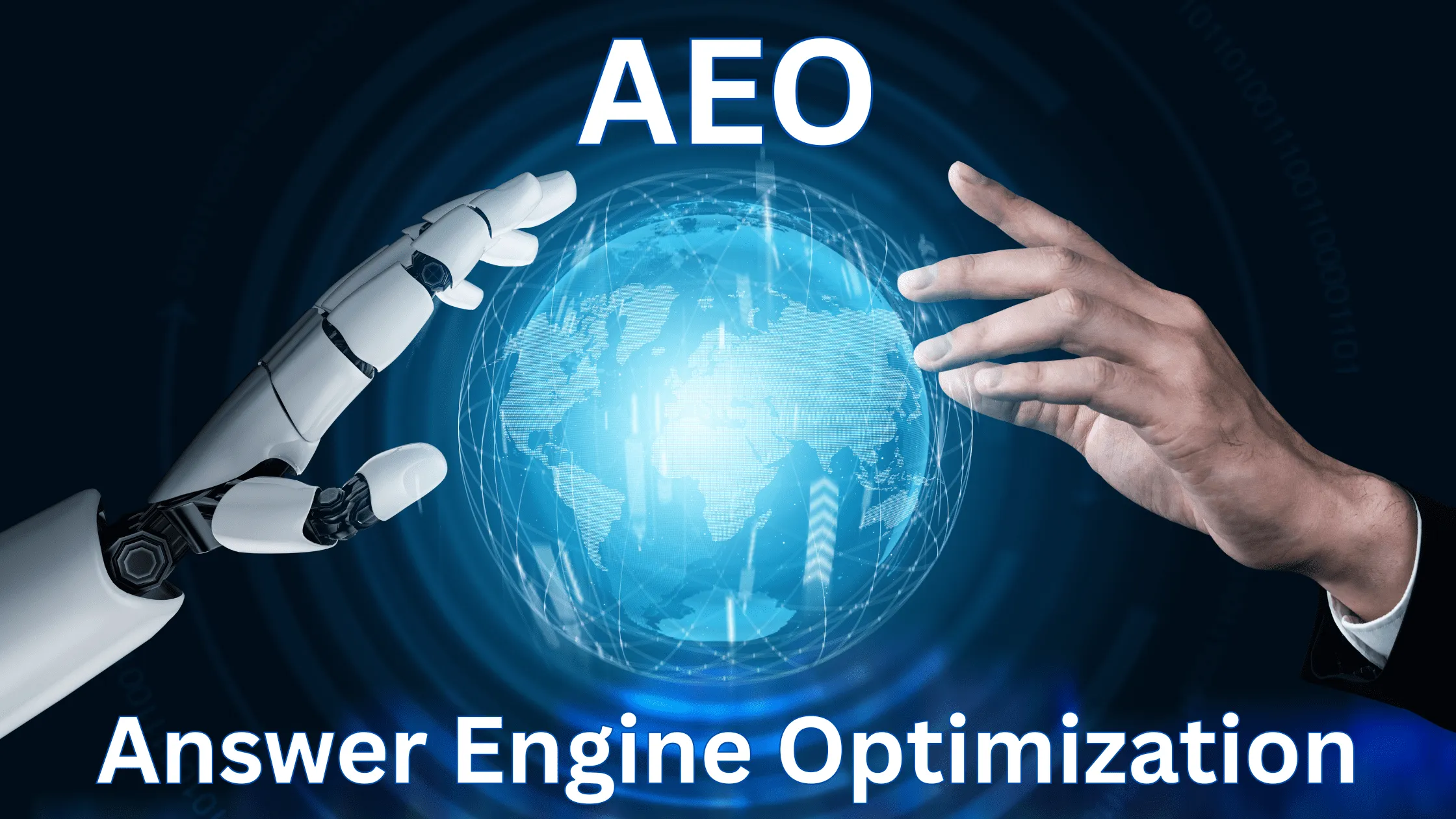What Are GEO and AEO Strategies and Why Do They Matter in the Age of AI?
Generative Engine Optimization (GEO) prepares content for AI-driven search engines and language models by creating comprehensive, semantically rich material that AI systems can interpret and cite. Answer Engine Optimization (AEO) transforms content into direct answers for voice assistants, chatbots, and AI-powered tools through structured data and conversational formats.
These strategies matter because AI-generated search results are reshaping how users discover information. Traditional SEO alone no longer guarantees visibility when AI platforms like Google SGE and Bing AI curate responses without directing users to websites. Partnering with an AEO digital agency ensures that your content is properly structured, AI-readable, and positioned to appear in these emerging answer-based environments. Businesses risk becoming invisible if their content isn’t optimized for AI interpretation.
The digital marketing evolution demands adaptation. Companies implementing GEO strategies build topical authority through pillar pages and expert content clusters. Those leveraging AEO strategies capture voice search traffic and zero-click searches through FAQ sections and schema markup. Without these approaches, businesses surrender competitive advantage to rivals who understand how AI-generated search results prioritize authoritative, structured, and conversational content.
How Can Businesses Optimize for Generative Engines (GEO) to Improve Their Search Visibility?
Generative engine optimization targets AI language models like ChatGPT, Google’s SGE, and Bing AI by structuring content in ways these systems can easily parse, understand, and cite. Unlike traditional search engines that rank pages, generative engines synthesize information from multiple sources to create comprehensive responses, making it essential for businesses to position their content as the authoritative source AI models reference.
1. Aligning with User Intent
User intent alignment forms the foundation of successful GEO implementation. AI models prioritize content that directly addresses specific user needs rather than keyword-stuffed pages. Businesses should analyze the questions their audience asks and create content that provides complete, actionable answers. A software company, for example, might develop content addressing “how to integrate payment APIs” rather than simply targeting “payment API” as a keyword.
2. Establishing Topical Authority
Topic clusters establish topical authority by organizing related content around central themes. This structure helps AI models understand the depth of expertise a business offers. Creating a pillar page on “cloud security” with supporting articles on encryption methods, compliance standards, and threat detection signals comprehensive knowledge that generative engines value.
3. Enhancing AI Interpretation
Semantic content enhances AI interpretation by using natural language patterns, contextual relationships, and entity-based writing. Instead of repetitive keyword usage, businesses should incorporate synonyms, related concepts, and industry terminology that AI models recognize. Writing “customer relationship management platforms help sales teams track interactions and nurture leads” provides richer semantic signals than simply repeating “CRM software” throughout the text.
4. Increasing Trustworthiness through Authoritative Content
Authoritative content backed by data, expert insights, and credible sources increases the likelihood of AI citation. Including statistics, case studies, and original research positions content as trustworthy information that generative engines can confidently reference when answering user queries.
What Are Practical Tactics Businesses Can Use to Implement GEO Effectively?
Building Topical Authority
Topical authority building starts with creating comprehensive pillar pages that serve as authoritative hubs for broad topics within your industry. These pages should contain 2,000+ words of in-depth analysis, covering every angle of a subject while linking to supporting cluster content that explores specific subtopics. A SaaS company might build a pillar page on “Customer Retention Strategies” that connects to detailed articles on churn analysis, onboarding optimization, and loyalty programs.
Creating Expert Content Clusters
Supporting this structure requires publishing expert content clusters consistently—aim for 3-5 related articles per month that reference and strengthen your pillar content. Each cluster piece should demonstrate specialized knowledge through case studies, data-driven insights, and practical frameworks that AI models can extract and cite as authoritative sources.
Improving Engagement Metrics
Engagement metrics directly influence how AI systems evaluate content quality and relevance. AI models interpret high click-through rates and extended dwell time as signals that your content satisfies user intent. To boost these metrics:
- Craft compelling meta descriptions that promise specific value
- Use descriptive, benefit-focused headlines that match search intent
- Structure content with scannable subheadings and visual breaks
- Include interactive elements like calculators or assessment tools
- Embed relevant videos that encourage longer page visits
Enhancing Semantic Optimization
Semantic optimization requires moving beyond keyword density to contextual relevance. Use entity-based language that connects related concepts—instead of repeating “email marketing,” incorporate related terms like “campaign automation,” “subscriber segmentation,” and “deliverability optimization.” This semantic richness helps AI models understand the full scope of your expertise.
Aligning with Natural Language Patterns
Implement natural language patterns that mirror how users actually ask questions. Replace formal business jargon with conversational phrasing: “How do I reduce cart abandonment?” rather than “Cart abandonment reduction methodologies.” This alignment with query patterns increases the likelihood of AI systems selecting your content for generated responses.
How Answer Engine Optimization (AEO) Improves User Experience and Strategies for Businesses to Optimize Content
Answer engine optimization transforms traditional search engines into direct answer providers, delivering immediate, precise responses through AI-powered tools like voice assistants and chatbots. This approach eliminates the need for users to click through multiple results, creating a frictionless experience that meets information needs instantly. The shift toward zero-click searches means businesses must position their content as the authoritative source AI systems pull from when generating responses.
1. Implementing Structured Data
Schema markup serves as the backbone of effective AEO strategy. This code helps AI systems understand content context, relationships, and meaning with precision. Businesses implementing structured data for FAQs, products, reviews, and how-to content see dramatic improvements in visibility across AI-generated results.
Key schema types for AEO include:
- FAQ Schema: Structures question-and-answer pairs for direct extraction by voice assistants
- HowTo Schema: Breaks down step-by-step instructions into machine-readable formats
- Product Schema: Enables AI to surface pricing, availability, and specifications instantly
- Review Schema: Displays ratings and testimonials in response to evaluative queries
2. Creating Content Formats That Drive AEO Success
AI systems favor content organized for conversational queries. Q&A sections mirror natural speech patterns, making them ideal for voice search optimization. How-to guides with clear, numbered steps allow AI to extract and recite instructions verbatim. FAQ pages addressing specific user questions become prime candidates for featured responses.
The language style matters significantly. Concise answers using natural, conversational tone align with how people interact with voice assistants. Businesses should craft responses that sound authentic when read aloud, avoiding jargon or overly complex sentence structures. Each answer should stand alone as a complete thought, typically ranging from 40-60 words for optimal AI extraction.

Which Industries Benefit Most from Leveraging GEO and AEO Strategies?
1. E-commerce Optimization
E-commerce optimization thrives when businesses implement geo-targeted keywords to capture local search intent. Online retailers using GEO strategies optimize product pages with location-specific terms like “organic coffee beans in Portland” to appear in AI-generated shopping recommendations. These businesses create comprehensive product guides and comparison content that AI models reference when answering purchase-related queries.
2. SaaS Digital Marketing
SaaS digital marketing teams leverage FAQ-driven AEO strategies to transform customer support documentation into searchable answer formats. Want to get more about digital marketting click here. Software companies structure their knowledge bases with schema markup, enabling AI assistants to pull precise troubleshooting steps and feature explanations. This approach reduces support ticket volume while improving user satisfaction through instant, accurate responses.
3. Healthcare SEO Strategies
Healthcare SEO strategies combine both approaches by optimizing symptom checkers and treatment guides for AI interpretation. Medical practices use GEO to establish topical authority around specific conditions while implementing AEO-friendly Q&A formats that voice assistants can cite. Local clinics particularly benefit from geo-specific health content that answers “near me” queries through AI-powered search results. Click here to get how a GEO Agency redefines AEO and SEO for the generative search era.
What Are Future Trends Impacting GEO and AEO Strategies?
Semantic search evolution is changing how AI engines understand content, moving beyond just matching keywords. Now, modern AI systems can analyze context, relationships between concepts, and user intent with incredible accuracy. This means businesses need to organize their content around covering entire topics instead of just focusing on individual keywords.
The rise of screenless browsing trends through smart speakers and voice assistants is making AEO optimization even more important. Voice searches usually have 3-5 more words than text searches and follow natural conversation patterns. As a result, content needs to directly answer questions asked in everyday language.
AI engines are increasingly focusing on:
- Entity-based understanding that connects related concepts across your content ecosystem
- Natural language processing capabilities that favor conversational, question-answer formats
- Zero-click results where AI provides complete answers without requiring users to visit websites
To keep up with these changes, businesses must create content that AI can easily extract, combine, and present as authoritative answers. This involves organizing information in a clear hierarchy, using headings that pose questions, and providing concise yet comprehensive responses that AI systems can confidently reference.
How Can Businesses Ensure Long-Term Success with Their GEO and AEO Efforts?
Content freshness determines whether AI systems prioritize your information over competitors. AI-driven search engines favor recently updated content, making regular refreshes with current data, statistics, and insights essential for maintaining visibility in generative results.
Businesses must audit their content quarterly, updating outdated information and adding new developments in their industry. This practice signals to AI engines that your content remains authoritative and trustworthy.
Natural language updates transform how content resonates with AI interpretation. Shifting from keyword-stuffed text to conversational phrasing mirrors how users interact with voice assistants and chatbots. Write as if answering a colleague’s question rather than optimizing for search algorithms.
Key maintenance practices include:
- Revising content to match current conversational query patterns
- Incorporating long-tail questions users actually ask
- Testing content against voice search devices
- Monitoring AI-generated summaries featuring your brand
This dual focus on freshness and natural language positions businesses to dominate AI-generated results across evolving platforms.



